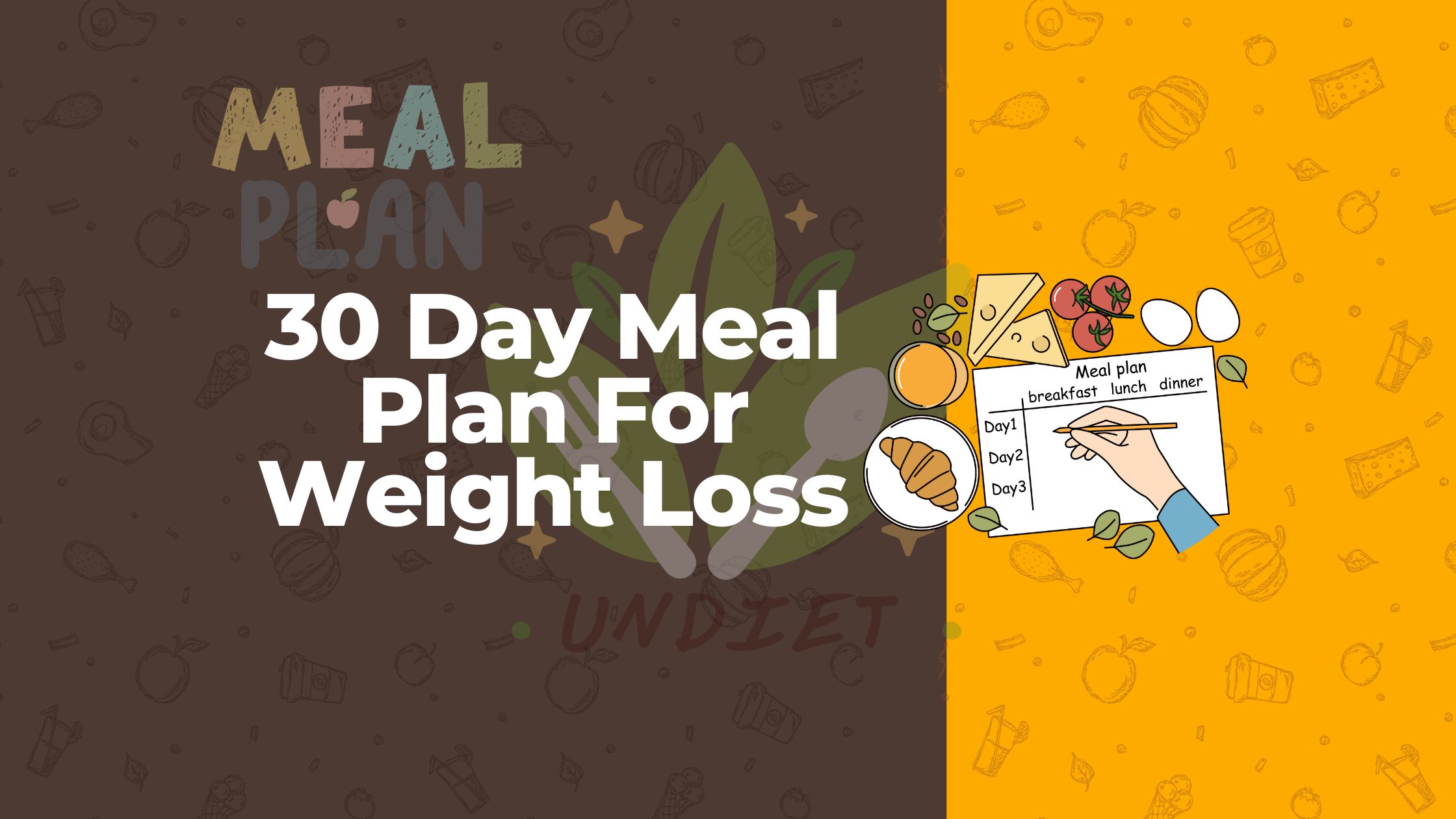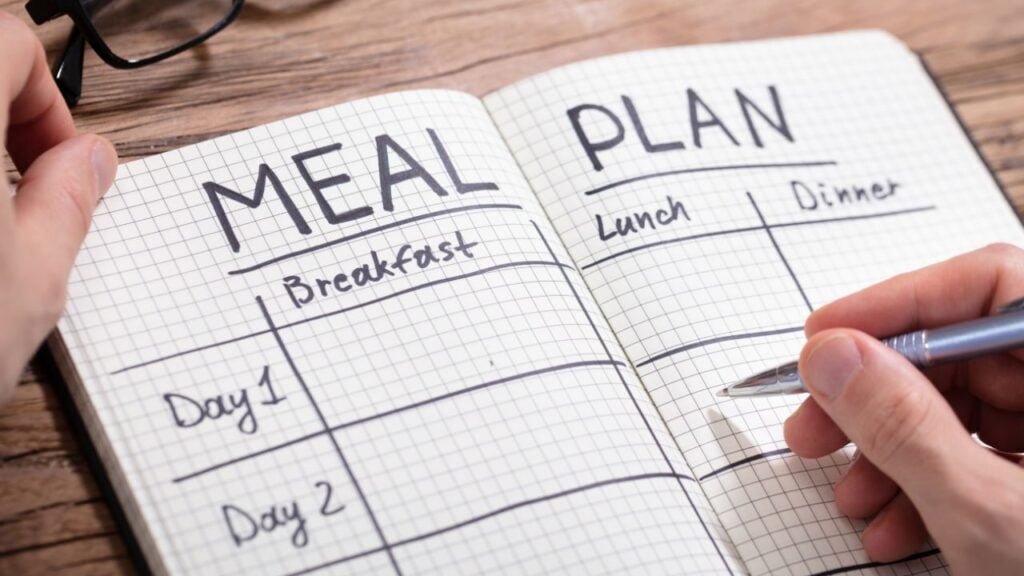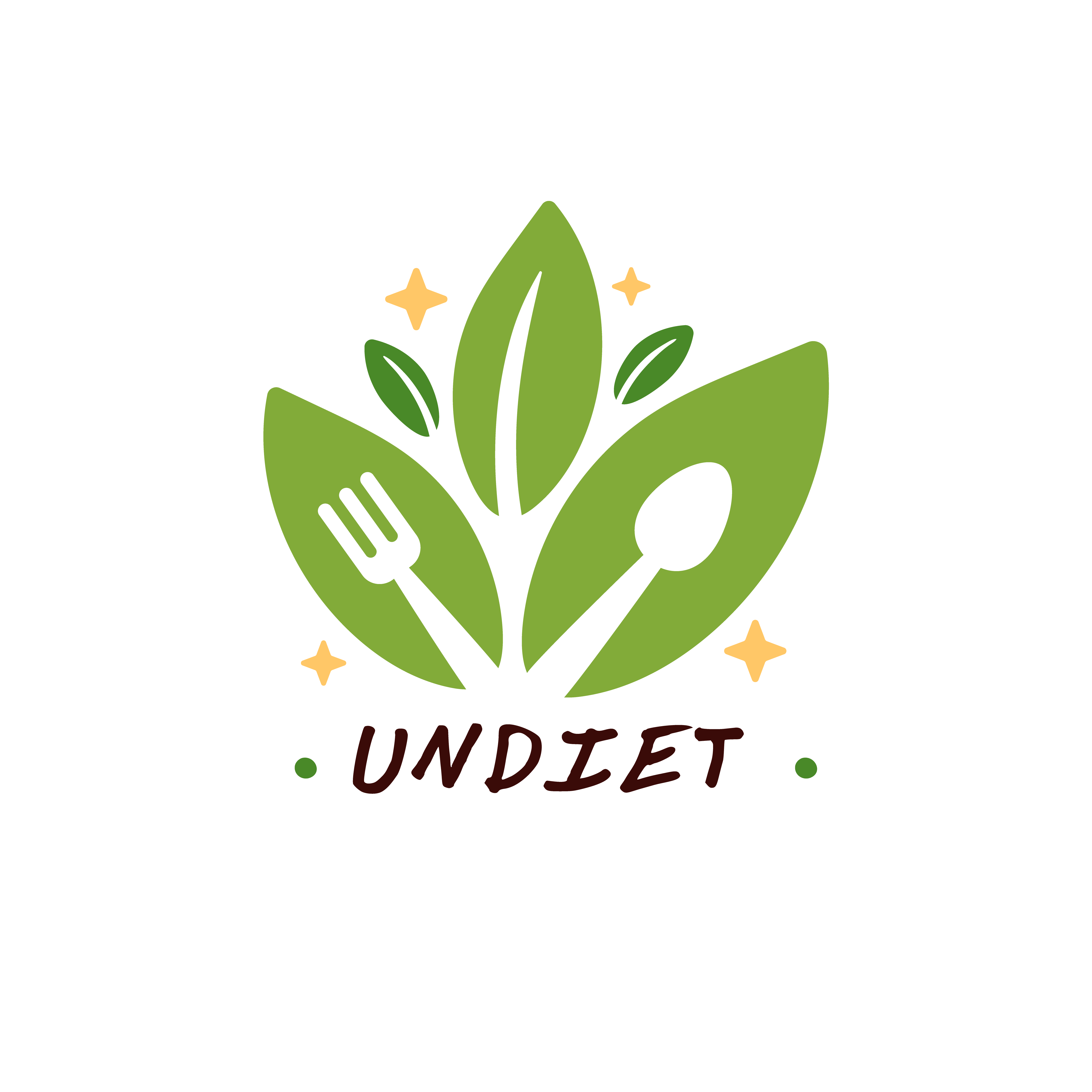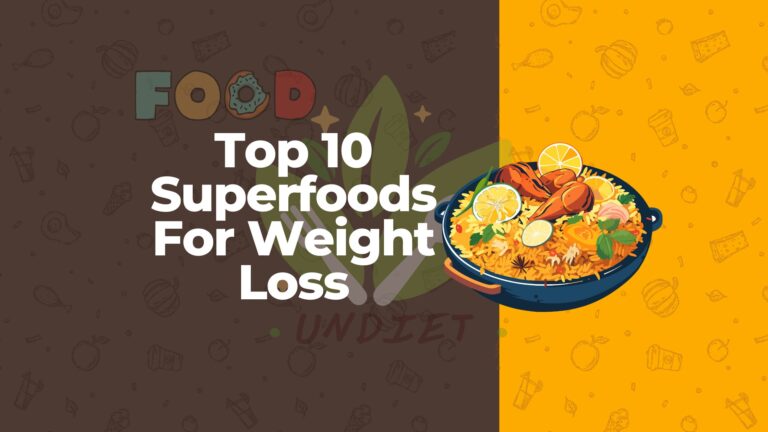The Ultimate 30 Day Meal Plan For Weight Loss

A 30 Day Meal Plan for Weight Loss provides structured daily menus to reduce calorie intake. It typically includes nutrient-rich foods in controlled portions to promote fat loss.
Embarking on a weight loss journey can be daunting, but a well-organized 30 Day Meal Plan For Weight Loss simplifies the process. This structured approach eliminates guesswork, ensuring that you consume balanced portions of proteins, fibrous carbohydrates, and healthy fats. It’s designed to kickstart your metabolism and encourage steady weight reduction while maintaining satiety and providing the energy necessary for daily activities.
The key to success is meal diversity, which prevents diet fatigue and fosters a sustainable healthy eating pattern. By committing to a predetermined set of meals, you can resist temptation and stay on track with your weight loss goals. Eating at regular intervals also keeps blood sugar levels stable, helping to curb cravings and control appetite. Join countless others who have transformed their lives, one meal at a time.
Crafting Your 30 Day Meal Plan For Weight Loss
Embarking on a weight loss journey can be overwhelming, but taking it one step at a time with a 30 Day Meal Plan For Weight Loss simplifies the process. Structured eating plans are instrumental in nurturing healthy habits, ensuring nutritional balance, and efficiently reaching your target weight goals. Tailor a personalized plan that aligns with your body’s needs and keep your motivation high as you visualize your progress over the consequent 30 days.
Importance Of Structure In Weight Loss
A structured meal plan is the backbone of effective weight management. Knowing what to eat, how much to eat, and when to eat lays a solid foundation for steady weight loss. Structure eliminates guesswork, reduces mealtime stress, and helps sidestep impulsive eating.
- Streamlines grocery shopping
- Controls portion sizes
- Increases diet adherence
- Sustains energy levels
Benefits Of A Meal Plan For Targeted Results
One size does not fit all, especially concerning meal planning for weight loss. Tailoring a plan to suit individual preferences and nutritional needs directly enables focused results. A customized meal plan:
- Maximizes nutrient intake – Aligns meals with the essential vitamins and minerals.
- Boosts metabolism – Includes food known for enhancing metabolic rate.
- Facilitates mindful eating – Encourages eating with intention and awareness.
- Minimizes food waste – Pre-purchase and prep prevent overbuying.
How This Guide Helps You Create Your Plan
This guide is more than a mere template; it’s a companion in your weight loss journey. By following the step-by-step instructions and mixing and matching from the diverse options provided, you can conceive a plan that is:
- Realistic – Based on your lifestyle, schedule, and food preferences.
- Flexible – Offers the ability to switch meals to prevent boredom.
- Adaptable – Can be adjusted as per changing goals or nutritional needs.
- Clear – Provides specific directions for preparation and portions.
Understanding Nutritional Basics

Embarking on a 30 day meal plan for weight loss requires a foundational understanding of nutritional basics. This knowledge is not only crucial for setting realistic goals but also for ensuring that your body receives the necessary fuel to function optimally while shedding excess weight. Grasp the roles of macronutrients, learn about creating a caloric deficit, and recognize the importance of hydration and fiber. This cornerstone will be your guide as you navigate through your weight loss journey.
Macronutrients And Their Roles
Nutrition pivots on the balance and intake of macronutrients, which provide the body with energy and support numerous bodily functions. Here’s a quick glance at the three primary macronutrients and their roles:
- Proteins: Essential for muscle repair, growth, and maintaining a strong immune system.
- Carbohydrates: The main source of energy for the body, particularly for the brain and during high-intensity exercise.
- Fats: Vital for hormone production, cell health, and nutrient absorption.
Ensuring a balanced intake of these macronutrients is foundational to any meal plan geared towards weight loss.
Caloric Deficits And Weight Loss
To achieve weight loss, one must understand the principle of a caloric deficit: burning more calories than what one consumes. It is through this mechanism that the body begins to tap into stored fat for energy, thus leading to weight loss.
| Activity | Caloric Expenditure |
|---|---|
| Moderate Exercise (1 hour) | About 300-600 calories |
| Daily Living Activities | Varies |
This table showcases an overview of the potential caloric expenditure from various activities. Creating a deficit might involve combining dietary changes with physical activities.
Importance Of Hydration And Fiber
Hydration plays a pivotal role in weight loss. It aids in digestion, flushes out toxins, and can often be mistaken for hunger. A well-hydrated body is essential for efficient metabolic processes. Aim for:
- Approximately 8-10 glasses of water daily.
- More if you are exercising or in a hot climate.
Fiber, on the other hand, contributes to satiety, helping you feel fuller for longer which prevents overeating. Foods high in fiber include:
- Vegetables
- Fruits
- Whole grains
- Legumes
Consuming a diet rich in fiber can also improve digestion and support the maintenance of a healthy body weight. Integrating both adequate hydration and a high-fiber diet are integral components of a successful weight loss meal plan.
Structuring Your 30 Day Meal Plan For Weight Loss
Welcome to the “30 Day Meal Plan for Weight Loss” where the journey to a healthier you doesn’t just hinge on what you eat, but also on how you structure your meals. Getting the balance right is crucial for shedding those unwanted pounds while ensuring your body gets the nutrients it needs to function optimally. Let’s dive into how to architect your meals to set you up for success!
Balancing Macronutrients
Understanding the correct mix of proteins, carbohydrates, and fats is essential for a balanced diet. Protein is vital for muscle repair and growth, carbohydrates provide energy, and fats are necessary for hormone production and nutrient absorption. Aiming for a plate that includes 40% carbohydrates, 30% protein, and 30% fats is a good rule of thumb for most individuals looking to lose weight.
Here’s a quick guide to help you balance your plate:
- Protein: Include lean sources like chicken, fish, tofu, or beans.
- Carbohydrates: Opt for complex carbs such as whole grains, sweet potatoes, or quinoa.
- Fats: Focus on healthy fats like avocados, nuts, and seeds.
Incorporating Diverse Food Groups
Diversity on your plate is key to prevent nutritional deficiencies and promote a healthy gut microbiome. Each food group provides different nutrients, so a varied diet ensures your body gets a wide range of vitamins, minerals, and antioxidants. Make sure to include a colorful array of vegetables, fruits, whole grains, lean proteins, and healthy fats in your daily meals.
| Food Group | Benefits |
|---|---|
| Vegetables | High in fiber, vitamins, and minerals. |
| Fruits | Rich source of antioxidants and natural sugars. |
| Whole Grains | Packed with fiber for digestion and sustained energy. |
| Lean Proteins | Essential for building and repairing tissues. |
| Healthy Fats | Supports hormone health and nutrient absorption. |
Timing Meals For Optimal Metabolism
When you eat can be just as important as what you eat. Structuring your meals to align with your body’s natural rhythms can boost metabolism and enhance weight loss. Aim for three main meals and one or two small snacks throughout the day, making sure not to skip breakfast. This consistent eating pattern helps regulate blood sugar levels and prevents overeating later in the day.
To maintain a steady metabolic rate, consider the following schedule:
- Breakfast: Start your day with a balanced meal within an hour of waking.
- Lunch: Keep your energy up with a hearty lunch around midday.
- Dinner: Finish your day with a lighter meal several hours before bedtime to promote good digestion.
- Snacks: Choose nutrient-dense snacks like nuts, yogurt, or fruit to curb hunger between meals.
Customizing The Meal Plan for Weight Loss

Welcome to the journey of transforming your diet with a 30 Day Meal Plan for Weight Loss. Understanding that each individual is unique, customizing the meal plan to fit your specific needs is paramount for success. Whether you have specific dietary restrictions, need to adjust caloric intake, or adapt meals to your activity level, tailoring your 30-day meal plan ensures you can achieve your weight loss goals while enjoying delicious and satisfying meals.
Adjusting For Dietary Restrictions
Eating according to your individual dietary needs doesn’t mean sacrificing flavor or variety. Here are several strategies for customizing your meal plan while respecting dietary restrictions:
- Gluten-Free Options: Opt for gluten-free grains like quinoa, brown rice, or certified gluten-free oats.
- Dairy Alternatives: Include almond, soy, or oat milk and vegan cheese alternatives to cater to lactose intolerance or a dairy-free diet.
- Vegetarian and Vegan: Ensure you’re getting enough protein by incorporating legumes, tofu, and plant-based protein powders.
- Low-Carb Requirements: Focus on lean proteins and low-carb vegetables, while limiting high-carb foods like bread and pasta.
- Allergy Conscious: Swap out any allergens for safe alternatives, ensuring no cross-contamination in food preparation.
Calculating Personal Caloric Needs
Understanding your personal caloric needs is a critical step in your weight loss plan. Here’s a basic guideline:
- Determine your Basal Metabolic Rate (BMR) using an online calculator or by consulting a healthcare professional.
- Factor in your daily activity level to estimate your Total Daily Energy Expenditure (TDEE).
- Subtract 500-1000 calories from your TDEE to create a calorie deficit conducive to weight loss.
- Remember that caloric needs vary based on age, sex, weight, height, and physical activity levels.
Adapting Meals For Activity Levels
Your daily energy output influences how much you should eat. Tailoring your meal plan to accommodate your activity level will help optimize your weight loss effort while ensuring you have enough energy to fuel your daily activities. Here are tips for adaptation:
- Low Activity: Focus on low-density, high-fiber foods that are satiating yet low in calories, like leafy greens and whole grains.
- Moderate Activity: Incorporate a balanced mix of carbohydrates, proteins, and fats to support your energy requirements.
- High Activity: Increase your intake of complex carbohydrates and lean proteins to support muscle repair and recovery.
Sample Meal Plan For Weight Loss
Welcome to your tailored 30 Day Meal Plan for Weight Loss. Embarking on this journey requires not only discipline but also an understanding of what your body needs. This sample meal plan is designed to introduce new, healthier eating patterns and is packed with nutritious, calorie-conscious meals to help you trim down while fueling your body. Remember, before starting any diet, consult with a healthcare practitioner to ensure it aligns with your individual health needs.
Week 1: Kickstarting Your Journey
This week is about gradually reducing your calorie intake and making small changes to your diet. It’s important to focus on hydration, portion control, and incorporating an abundance of fruits and vegetables. You may notice an increase in energy levels as you cut out processed foods and sugars.
Additional rows would follow for each day of the week, following a similar structure
| Day | Breakfast | Lunch | Dinner |
|---|---|---|---|
| Monday | Scrambled eggs with spinach and mushrooms | Grilled chicken salad with mixed greens | Stir-fried tofu with assorted vegetables |
Week 2: Introducing Variety And Balance
Variety is the spice of life, and this week we introduce a broader range of foods to prevent dietary boredom. The goal is to find a healthy balance of protein, carbs, and fats. This helps to nurture a diverse gut microbiome, which is essential for weight loss and overall health.
- Experiment with different protein sources like lentils, beans, and fish.
- Incorporate whole-grain carbohydrates like quinoa and brown rice.
- Use healthy fats such as avocado, nuts, and seeds in your meals.
Week 3: Building Healthy Habits
During the third week, the focus is on solidifying the practices that you’ve started. Meal prepping can be a game-changer during this phase. By now, your body starts to adapt to healthier choices, and cravings for unhealthy foods usually subside.
- Prepare a week’s worth of meals in advance to avoid impulsive eating.
- Ensure to drink at least 8 glasses of water daily.
- Snack on fruits, nuts, or yogurt instead of processed snacks.
Week 4: Solidifying Your Routine
The final week is about making your meal plan a sustainable part of your lifestyle. Continue to listen to your body’s hunger cues and make adjustments to meal sizes and ingredients as necessary. Consistency is key, so stick to your regular meal times and focus on maintaining the balance you’ve worked hard to establish.
- Stay consistent with portion sizes.
- Keep a variety of colored vegetables and fruits in the diet.
- Maintain a balance of proteins, carbs, and fats.
Shopping And Prep Strategies

Embarking on a 30 Day Meal Plan for Weight Loss requires more than just a list of foods and recipes; it demands a smart approach to shopping and meal prep. To streamline your diet and ensure success, solid strategies for grocery shopping, meal prepping, and food safety are non-negotiable. Let’s simplify the process and set you on the path to shedding pounds with minimal stress and maximum efficiency.
Efficient Grocery Shopping Tips
Smart shopping is critical for weight loss success. It saves time, and money, and keeps your meal plan on track. To optimize your grocery runs, follow these proven tips.
- Plan ahead: Before stepping out, list all the ingredients you’ll need for your weekly meal plan. This keeps you focused and helps avoid impulse buys.
- Choose whole foods: Prioritize fruits, vegetables, lean proteins, and whole grains. These foods are nutrient-dense and have fewer calories compared to processed items.
- Read labels: Always check nutritional information to avoid hidden sugars and fats, key culprits in weight gain.
- Shop the perimeter: Most grocery stores are designed with fresh produce and meats along the outer aisles. Sticking to the perimeter can minimize the temptation of less healthy, processed foods.
Meal Prepping For The Week
Once you’ve stocked up on groceries, the next step is turning those ingredients into easy, grab-and-go meals. Meal prepping is a powerful tool for anyone serious about weight loss.
- Create a meal schedule: Assign specific meals for each day of the week. This eliminates guesswork and helps you stay committed to your diet plan.
- Batch cook: Prepare multiple portions of your meals. Cook once and enjoy several servings weekly, saving time and energy.
- Portion control: Use measuring cups and a kitchen scale to ensure appropriate serving sizes. This keeps your calorie intake in check.
- Invest in quality containers: Good storage solutions keep your meals fresh and prevent spoiling. Opt for BPA-free, microwave-safe, and dishwasher-friendly containers.
Storing And Handling Food Safely
Safety is paramount when preparing and storing your meals. Implement these practices for optimum food safety and to reduce the risk of foodborne illnesses.
- Temperature control: Keep your refrigerator below 40°F (4°C) and your freezer below 0°F (-18°C) to slow bacterial growth.
- Cross-contamination avoidance: Use separate cutting boards and utensils for raw meats and other foods.
- Proper thawing: Thaw frozen foods in the refrigerator or in cold water, never at room temperature.
- Refrigerate promptly: Don’t leave prepared meals at room temperature for more than two hours. Refrigerate as soon as possible to maintain freshness.
Staying On Track with 30 Day Meal Plan
Embarking on a 30 day meal plan for weight loss is an exciting journey filled with nutritious recipes and the promise of a healthier lifestyle. But beyond the initial burst of motivation, Staying on Track becomes the real challenge. It involves meticulously monitoring progress, addressing cravings, and above all, maintaining consistency and patience. The following strategies will help you navigate this voyage, ensuring that your path to weight loss is as effective as it is sustainable.
Monitoring Progress And Making Adjustments
Tracking your progress is essential in a weight loss journey. It helps in assessing what’s working and identifying areas for improvement. Regular check-ins with your meal plan provide actionable insights and keep your goals within reach.
- Document daily intake to stay aware of eating habits.
- Use apps or a journal for meal tracking to simplify this process.
- Hold weekly weigh-ins and take body measurements to monitor physical changes.
- Analyze patterns and make necessary changes to your meal plan to overcome plateaus.
Dealing With Cravings And Setbacks
Cravings and setbacks are inevitable, but they don’t mean failure. Approach these obstacles with a plan, and you’ll be more likely to stay on course.
| Strategy | Action Plan |
|---|---|
| Healthy Alternatives | Keep nutritious snacks on hand to satisfy cravings without derailing your meal plan. |
| Mindful Eating | Engage fully with each meal to enhance satisfaction and avoid mindless snacking. |
| Emotional Support | Talk to friends or join a support group when feeling discouraged, to boost morale and stay on course. |
Importance Of Consistency And Patience
Weight loss is a marathon, not a sprint. Consistent efforts compound over time, leading to significant results. Trust the process and allow your body to adjust at its own pace. Remember, patience is key.
- Foster routine eating habits for a steady progression towards your goals.
- Stay dedicated to your meal plan, even if results seem slow initially.
- Resist the temptation of crash diets; sustainable weight loss takes time.
Beyond The 30 Day Meal Plan For Weight Loss
Embarking on a 30 Day Meal Plan for Weight Loss is an excellent kickoff to your wellness journey, but what happens when the thirty days are up? The true challenge often lies in maintaining the results and ensuring you don’t fall back into old habits. This section delves into critical strategies that will not only help you transition into a more sustainable lifestyle but also provide guidance on how to continue your weight loss journey and integrate meal plan strategies into your daily routine for the long haul. It’s time to turn short-term success into a lifelong triumph!
Transitioning to a Sustainable Lifestyle
After focusing intensely on a structured 30 day meal plan, the idea of maintaining a healthy dietary pattern can feel daunting. It’s crucial to evolve from the strict guidelines of a meal plan to adopting lasting dietary habits. A sustainable lifestyle doesn’t just end with what’s on your plate; it encompasses a balanced approach to food choices, mindful eating, and listening to your body’s signals.
- Explore diverse foods to keep your diet interesting.
- Intuitively eat, prioritizing hunger cues over scheduled meal times.
- Plan meals ahead but allow for flexibility.
Continuing Weight Loss Beyond The Plan
Achieving weight loss doesn’t stop after the initial 30 days. It’s a journey that requires persistence and continuous effort. To keep the momentum, set new, achievable goals and track your progress. Stay consistent with what works for you while being open to change and adaptation as your body and circumstances evolve.
- Monitor progress with a food diary or an app.
- Regularly refresh your goals to stay motivated.
- Adjust your calorie intake if weight loss plateaus.
Incorporating Meal Plan Strategies Long-term
The strategies you learned during the 30-day meal plan can serve as the foundation for your ongoing nutritional choices. Portion control, balanced macronutrient distribution, and a focus on whole foods are all elements that should follow you into the future. Jot these practices down so they become second nature:
| Meal Plan Strategy | Long-Term Application |
|---|---|
| Pre-portioned meals | Continue to control portions to avoid overeating. |
| Meal prepping | Make meal prepping a weekly habit to save time and resist temptation. |
| Eating high-fiber foods | Incorporate a variety of fiber-rich foods to maintain fullness and gut health. |
Frequently Asked Questions For 30 Day Meal Plan For Weight Loss
Is A 30 day Meal Plan Effective For Weight Loss?
Yes, a structured 30-day meal plan can be effective by providing controlled calorie intake and balanced nutrition that supports weight loss goals.
What Foods Are Included In The Weight Loss Meal Plan?
The meal plan includes lean proteins, whole grains, fruits, vegetables, and healthy fats to promote fullness and nutrient intake while reducing calories.
Can I Snack While Following The Meal Plan?
Yes, the plan allows for healthy snacks like nuts, yogurt, or fruit to keep hunger at bay and maintain energy levels throughout the day.
How Many Calories Per Day In The Meal Plan?
Calorie intake varies based on individual needs, but the plan typically ranges from 1200 to 1500 calories per day to promote safe weight loss.
Does The Meal Plan Cater To Dietary Restrictions?
Many 30-day meal plans are customizable to accommodate dietary restrictions such as vegetarian, gluten-free, or lactose intolerance options.
Will I Need To Exercise Along With The Meal Plan?
While the meal plan focuses on diet, incorporating regular exercise can enhance weight loss efforts and improve overall health.
How Much Weight Can I Lose In 30 Days?
Weight loss varies per individual, but safe weight loss is typically 1 to 2 pounds per week, so 4 to 8 pounds in 30 days is a realistic goal.
Are The Recipes In The Meal Plan Quick To Prepare?
The meal plan includes a mix of recipes, with many designed to be quick and easy to prepare to fit into a busy lifestyle.
Can I Repeat The Meal Plan After 30 Days?
Yes, the meal plan can be repeated or adjusted as needed for continued weight loss or weight maintenance after the initial 30 days.
Is The Meal Plan Suitable For Beginners?
Yes, the meal plan is designed to be user-friendly, with simple recipes and clear guidelines making it suitable for those new to structured dieting.
Conclusion
Embracing a 30-day meal plan can transform your weight loss journey. As we wrap up, remember consistency is key. Tailor choices to your tastes and goals for sustainable change. Ready to get started? Your healthier, happier self awaits. Let’s make each meal a step towards success!



